
On Climate Education and perfect cakes
9 November 2022
Zero Pollution Ambitions
15 November 2022by Philippine Chevalier, Iris Lassus, Vittoria Pagliaro
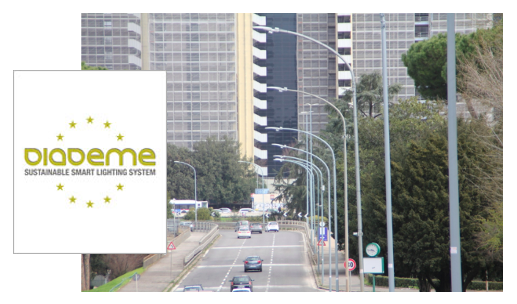
Picture 1
Can innovative projects contribute to energy transition and climate action?
Yes, according to the European Union. In order to facilitate this process, it established the LIFE programme, the EU’s instrument that provides funds for climate and environmental action, which celebrates its 30th anniversary this year (1992-2022).
Here’s a quick overview:
- it is a key instrument for the European Green Deal
- it was established by regulation (EU) No 1293/2013 of the European Parliament and of the Council
- so far it has co-financed more than 5500 projects
- its funds have been increased to €5.4 billion for 2021-2027
- it is divided into 4 sub-programmes:
1. Nature and Biodiversity
2. Circular Economy and Quality of Life
3. Climate Change Mitigation and Adaptation
4. Clean Energy Transition
Now let’s take a look at a virtuous project that has stood out within the Clean Energy Transition sub-programme. It’s the Life-Diademe Project, that won the “EU Sustainable Energy Awards 2021” in the “Innovation” category by devising an intelligent and transferable method for reducing street lighting consumption.
How much does street lighting matter?
The relevance of street lighting might be underestimated, but it is of great concern. Its reduction would bring a significant impact in the energy and climate transition. There are more than 90 million lighting pales in Europe, which are responsible for a great emission of Greenhouse gasses (GHG). The “Covenant of Mayors network” (2013) estimated that the electrical consumption of most European municipalities accounts for 50% of the share of the cities’ energy usage and about 60% of relative costs. Given the impact of public lighting, the ability to make savings in this area is a vital step towards climate change mitigation and that is what the Life-diadem project has tried to obtain in order to move towards the sustainable city. Let’s see how the project works.
LIFE-DIADEME Project in brief
WHAT?
LIFE-DIADEME is a cost-efficient solution that combines societal and environmental benefits through the use of innovative lights that have a large potential for replicability, transfer and mainstream adoption.
But why is it innovative?
In practice, it evaluates the traffic conditions and regulates the minimum luminance. In this way, this innovative technology is not only able to guarantee safe conditions for both drivers and pedestrians, but also to reduce consumption and optimize maintenance.
Thus, these results are important not only for the validation of the project, but also for its application on a national or global scale. As mentioned, there is massive pollution caused by lighting. Therefore, the dissemination of innovative and successful projects such as Life-Diademe is desirable for the widest possible audience.
HOW?
1. Each individual light point is equipped with sensors that monitor traffic conditions and luminance on the road
2. The information is transferred to a central unit (located on the switchboard level) where algorithms evaluate the conditions detected in a diffuse manner
3. These data can derive the light intensity levels that must be delivered by the individuals lighting points in compliance with the requirements of UNI11248
4. Each monitored zone guarantees correct lighting pursuing diffuse, intelligent and real-time control
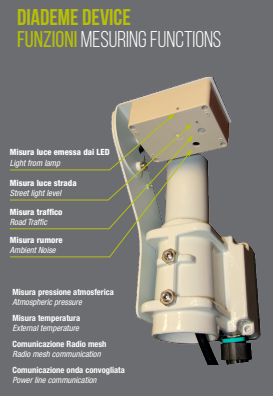
Picture 2
WHERE?
– Rome
– Piacenza
– Rimini
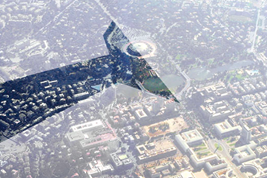
Picture 3
WHEN?
From October 2016.
Payback period: 8 years (compared to 30 years for the most technologically advanced solution available on the market).
What is the objective of the LIFE-DIADEME project?
“Demonstrate that a new, cost-efficient street lighting system can reduce energy consumption by 30% in comparison with state-of-the-art control systems”.
This is the main objective, but it carries within itself significant consequences that can be seen as secondary (but not less important) goals:
– with the lower activation of lights, there will be a decrease in light and air pollution (positive impact on biodiversity and wildlife behavior)
– thanks to the technology used, it is possible to gather and accumulate data not only on the necessary lighting, but also on traffic, noise and air pollution
– all of this important information is therefore collected at all times and can serve as a basis for the expansion of the project on a larger scale.
The project looks promising. Now let us look at the obtained results.
‘We have worked to ensure that the technology can monitor and adapt to real-time traffic and weather conditions while also monitoring air quality,’ said LIFE-DIADEME Project Manager Andrea Mancinelli. ‘To be recognised by the European Commission for our efforts is truly an honor.’
Did the Diademe project win its worth ?
As detailed above, the double target of the project was to have a concrete energy efficiency improvement along with an accumulation of data at the city level to support planning and policymaking. Looking at the results of the Project, we can argue that it was a real success : the double initial target was undeniably reached. More than that: the results are much higher than what was expected.
Energy consumption
At the very beginning of the project, the most ambitious expectations announced reductions of about 30%. The selection of technologies and materials, the search for the best components and solutions to reach these expected performances were a real struggle in the first years of the project. This was worth the shot. After months of technical improvements in the field and a range of appliances tests, the project demonstrated that the adaptative Diademe systems definitely succeeded in reducing significantly energy consumption. An estimated reduction of 57% on average compared to a full light system. In comparison to a pre-programmed system, an estimated 41% reduction has been observed.
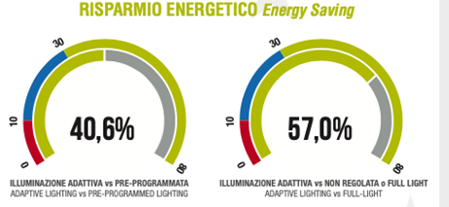
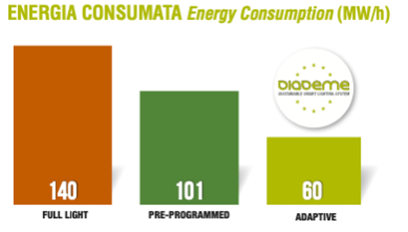
Picture 4 & 5
Data accumulation
As you might have understood, the Diademe project is not just about reducing energy consumption. It is also about thinking the smart city of tomorrow and accumulating city level data to better build innovative policies. Based on several parameters, the Diademe technology automatically adapts the lighting intensity. Among them, we find uninterrupted traffic loads monitoring, the detection of luminance and weather conditions as well as pollutants. Thanks to this, the project ended up with reliable urban noise and air quality maps including observations of traffic flows. These useful data have a real added value as they are at the very basis of the elaboration of typical Smart Cities scenario.
Circular economy concern
The life cycle of the materials used was also a central concern for the Diademe team. Beyond being efficient in terms of energy consumption, the Diademe technology enhances the reliability of the system and reduces the maintenance needed. As a result, the quantity of electronic waste produced is reduced by 542 Kg per year. Compared to standard street lighting devices, the developed technology has really demonstrated life cycle benefits of the components used.
Is that all ?
Another successful aspect of the project is that, beyond the initial very purpose of it, it will generate significant positive side effects. In the long term, thanks to the numerous sensors settled, the project will indirectly contribute to improvements in air quality, environmental noise and more largely on the environmental impact in urban environments. Furthermore, the lower level of street lighting allowed by the Diadem systems could also generate a positive impact on biodiversity. Light pollution is a real issue for the wild living beings settled in cities. Regarding the global collapse of biodiversity throughout the world and its exacerbation in urban areas, it is very crucial today to address this issue together with smart cities plans.
The success of the Diademe project also relies on its capacity to function in the long run. Beyond the commitment of the three participating Italian municipalities to ensure the long-term environmental benefits of the project, the Life cycle cost assessment also demonstrated economic benefits. A return of investment in less than three years is expected, and a potential payback time in around two years in ideal conditions. The underlying ambition of the Diademe team is such that a new target has been outlined : 200 000 installations in the 10 years following the project end.
Will the project directly implement the EU legal provisions regarding energy efficiency ?
Most of all, the project directly contributes to implementing the Energy Efficiency Directive 2012/27/EU as amended by EU 2018/2022, as well as the Green Public procurement legislation, defined in the Directive 2014/24/EU.
More largely, the relevancy of the project finally relies on its very precise articulation with the European framework regarding energy efficiency but not only :
– Europe 2030 Energy strategy
– Green Paper “Lighting the Future” (COM(2011)0889)
– EU Strategy on adaptation to climate change (COM(2013)216)
– EU Adaptation Strategy (COM(2013)216) and the Mayors Adapt initiative
– Directive 2011/65/EU (Restriction of Hazardous Substances in Electrical and Electronic Equipment)
– Directive 2012/19/EU on WEEE (Waste Electric and Electronic Equipment)
– Directive 2022/49/EC on assessment and management of environmental noise
– Directive 2008/50/EC on air quality.
In a nutshell, by targeting different European policies, the Diademe project has a real added value, which is its ability to simultaneously address different energy challenges. Yet, transversality is key for thinking the smart city of tomorrow. And this is something the Diademe team undoubtedly understood.
How can these results be extended to other countries?
The question now is to what extent the idea of the Diademe project, and thus Smart Lighting, can be extended on a larger scale and in other countries. Smart lighting has advantages and disadvantages, the balance of which is mediated by policy objectives and their application.
Thinking about the implementation of Smart Lighting in European cities means first of all taking into account that each city is different, whether in terms of existing lighting infrastructures, local needs, resources, cultural values and of course priorities. The application of Smart Lighting on a large scale is therefore not a simple matter.
As we have seen with the Diademe project, smart lighting is an effective way to save energy and reduce CO2 emissions. But the impact of smart lighting goes far beyond that , and all the advantages of this type of technology (reducing light pollution, reducing costs and increasing the efficiency of maintenance, etc.) must be promoted for large-scale integration. The benefits of Smart Lighting could also directly affect citizens, through its implementation in the event of an emergency, the supply of light for specific needs in specific places or by developing the attractiveness of pedestrian and cycle paths. In addition, the functionalities of intelligent lighting extend, for example, to the identification of traffic or safety problems, or the monitoring of air quality thanks to the information collected by radars and sensors
Difficulties to be taken into account for the implementation
Before thinking about how to implement this type of technology on a large scale, it is necessary to consider the limits of Smart Lighting.
- For citizens, the smart street lamps raise privacy and surveillance concerns, given the data that could be collected. As more advanced sensors, such as smart traffic cameras, enter Smart Lighting applications, this type of problem could be more and more frequent.
- The financing of Smart Lighting technologies is one of the first difficulties encountered by cities. City budgets are generally limited and the transition to these technologies is not the priority. In addition, Smart Lighting requires additional networks which are another source of costs. Finally, the payback period can be an obstacle.
- At the technical level, given the complexity of the technology and the sensors to be installed, Smart Lighting induces a need for technical training and advanced safety for workers, which means a high level of education. Then, a major difficulty can be the uninterrupted power supply necessary for the operation of the systems. Also, Data protection and cybersecurity issues need to be considered as well for the integrated smart streetlamps.
- Finally, governance issues can challenge Smart Lighting. There is the question of the responsibility of the city in the event of technical problems which would lead, for example, to road accidents linked to too low intensity of streetlamps or smart traffic lights.
Ways to go towards implementation
Cooperation
Now let’s get to the implementation. The development of Smart Lighting in cities must be led by various actors in cooperation. Local leaders and decision-makers must obviously be involved from the start of the project since they know the specific needs of the different neighborhoods of the city. They are responsible for assessing what needs to be done and how to do it. Public lighting experts should accompany them throughout the project. The largest municipalities could also create a specialized department or working group to accumulate and share knowledge within them. It would be interesting to consider collaborations between cities in order to aggregate demand and reach a better deal with the market. As for regional and national governments, they play a major role through their ability to tackle regulatory obstacles, stimulate and facilitate the aggregation of demand or even provide access to advantageous financing models.
Informing citizens
Citizens must be informed and involved throughout the implementation of the project. As discussed previously, it is crucial to anticipate the negative impacts that the collection of data could cause and to clearly define the parties having access to it and their uses, taking into account the GDPR. It is also a question of thinking about the ever-increasing automation of the city and its effects on employment. Thus, Smart Lighting can only be achieved with strong support from citizens. For this, we must imagine new forms of participation in order to involve citizens, civil society and private companies in the creation of the project.
Interoperability
Finally, another implementation aid is interoperability. In a market in full atomization, it is necessary for client cities to be able to ensure that every device in the Smart Lighting network should be replaceable with an equivalent device from a different brand and function plug and play with management software.
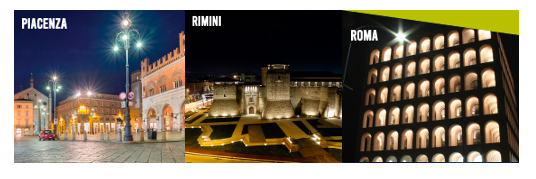
The three municipalities where the Diademe Technology was implemented. Taken from the Layman’s Report.
Picture 6
Bibliography:
- COLCLOUGH Graham (AC chair and Initiative lead), Smart lighting in cities, EUSmartCities, https://smart-cities-marketplace.ec.europa.eu/sites/default/files/2021-06/Smart%20Lighting%20Factsheet_0.pdf
- Energy Efficiency Directive 2012/27/EU as amended by EU 2018/2022 https://eur-lex.europa.eu/legal-content/EN/TXT/?uri=uriserv:OJ.L_.2018.328.01.0210.01.ENG
- GORMLIE Frank, More Debate Over San Diego’s Secret Streetlight Cameras, october 31 2019, https://obrag.org/2019/10/more-debate-over-san-diegos-secret-streetlight-cameras/
- GREEN PAPER Lighting the Future Accelerating the deployment of innovative lighting technologies, COM/2011/0889 final, https://eur-lex.europa.eu/legal-content/EN/ALL/?uri=celex:52011DC0889
- LEWIS Sarah, Smart streelight, Tech Target, December 2019, https://www.techtarget.com/iotagenda/definition/smart-streetlight
- Life-DIADEME victorious in EU Sustainable Energy Awards, European Commission, October 2021 https://cinea.ec.europa.eu/news-events/news/life-diademe-victorious-eu-sustainable-energy-awards-2021-10-29_en
- Life-Diademe, https://www.diademe.it
- Life is 30, Informative Factsheet, https://www.lifeis30.eu/wp-content/uploads/2022/02/LIFEis30-Informative-factsheet.pdf
- 30 Years of bringing new ideas into Life, https://www.lifeis30.eu
- Life-Diademe: demonstrating the energy-savings benefits of an adaptive street lighting system in Italy https://www.lifeawards.eu/project/life-diademe/
- Progetto Life-Diademe per l’illuminazione pubblica, Comune di Piacenza, February 2020 https://www.comune.piacenza.it/documenti-e-dati/accordi-con-enti-e-privati/progetto-life-diademe-per-lilluminazione-pubblica
- LIFE 3.0 – LIFE Project Public Page. (s. d.). https://webgate.ec.europa.eu/life/publicWebsite/project/details/4566
- Petritoli E., Leccese F., Pizzuti S., Pieroni F., Smart lighting as basic building block of smart city: An energy performance comparative case study,Measurement,Volume 136,2019,Pages 466-477, https://doi.org/10.1016/j.measurement.2018.12.095
- An EU scheme could use “smart streetlights” to cut energy bills and create Wi-Fi hotspots https://citymonitor.ai/smart-cities/eu-scheme-could-use-smart-streetlights-cut-energy-bills-and-create-wi-fi-hotspots-670
- European cities want 10 million ‘smart’ streetlamps https://www.euractiv.com/section/smart-cities/news/european-cities-want-10-million-smart-streetlamps/
- ROSS Philip and LUCI Association, A Cities’ Guide to Smart Lighting, LUCI Association, November 2021, https://www.luciassociation.org/wp-content/uploads/2022/01/Cities-Guide-to-Smart-Lighting_digital-edition-LUCI.pdf
- The Green Public procurement legislation, defined in the Directive 2014/24/EU https://eur-lex.europa.eu/legal-content/EN/TXT/PDF/?uri=CELEX:32014L0024


